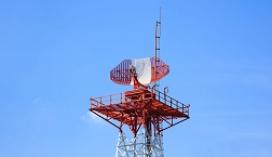Improving Asset Management at Unstaffed FAA Facilities
Volpe leverages its asset management expertise to help the Federal Aviation Administration (FAA) facility infrastructure team review maintenance needs and upgrades for unstaffed facilities.
The FAA Unstaffed Infrastructure Sustainment (UIS) Program manages, assesses, and refurbishes unstaffed facilities, including buildings and broadcast towers that house critical National Airspace Systems. These systems are essential for communication, navigation, surveillance, and weather monitoring. There are 28,000 unstaffed facilities and 77 facility types nationwide.[1]
The Challenge
Many FAA unstaffed facilities do not comply with building standards and have weakened structures, according to a Government Accounting Office review. These failures reduce the capacity of the nation’s airspace, and new technology can suffer premature failure when it is deployed into aged infrastructure.
Unstaffed facilities have an anticipated service life of 25 years, and more than 50 percent of unstaffed infrastructure will exceed its service life by 2017, according to the Facility Service and Equipment Profile database. To keep the national airspace safe and efficient for commercial and cargo travel, FAA must ensure that its unstaffed facilities are in good repair.
The Solution
After FAA completed a programmatic review of UIS towers, the agency turned to Volpe for expertise in aligning the UIS Program with the asset management maturity framework—a tool that helps agencies evaluate their ability to manage their properties and estimate future asset needs.
Volpe asset management experts worked with the FAA facility infrastructure team to make sure that the UIS Program had clear strategies for assessing the health of unmanned facilities, and for identifying upgrades so that facilities remain modern and effective. Volpe experts developed program budgets and organizational policies and procedures, provided program implementation and monitoring, and prepared cost estimates for maintenance and upgrades through life cycle analyses.
Limited budgets mean that only select unstaffed structures can be upgraded. As a result, Volpe experts team with FAA staff to prioritize work plans for each fiscal year. As part of that support, Volpe developed and now operates a geographic information system (GIS) that FAA uses to monitor its network of unstaffed infrastructure. This GIS tool improves communication between FAA headquarters and staff who maintain and operate equipment at unstaffed structures by allowing both parties to see, analyze, and make repair plans for structures virtually and simultaneously.
Volpe also manages the entire construction process when unstaffed facilities need upgrades and maintenance. Experts survey facilities, often in remote locations; determine work that needs to be done; create engineering designs to repair or build new facilities, and then oversee construction.
The Impact
As a result of Volpe’s support for FAA, the UIS Program is improving its internal processes for managing and maintaining the nation’s unstaffed aviation infrastructure. More accurate and credible information on facilities in the UIS portfolio makes it easier for FAA to plan and prioritize projects.
[1] FAA Capital Investment Plan 2014 – 2018, p. 205.
Customer

Federal Aviation Administration
